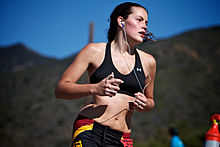jogging

Jogging ( engl. Jog "plodding"), also known as continuous operation referred to is a form of leisure or country skiing , in which by leisurely endurance tests the condition is increased (endurance).
history
In Germany, the Waldniel doctor Ernst van Aaken organized endurance running groups as early as the 1950s. The breakthrough came, however, through the New Zealand trainer Arthur Lydiard (1917-2004), who no longer organized endurance runs in the forest or on the sports field, but on the streets for everyone to see. This makes him the inventor of jogging. He founded the first jogging club in 1961. The American runner, trainer and designer Bill Bowerman (1911–1999) brought the idea to the USA in 1962 after a visit to New Zealand , from where the jogging movement spread around the world.
Effects
As a form of endurance training, jogging not only increases physical endurance , but also the physical performance of the body. It also strengthens the cardiovascular system . It also has a positive effect on bone density . In overweight people, jogging can contribute to a negative energy balance and therefore has a supportive effect on a diet , because the output is increased. Jogging increases fitness and the daily requirement for energy intake from food , since a person consumes approx. 3000–3350 kJ / h (700–800 kcal / h). The step frequency is between 140 and 170 steps per minute. If the body mass index is greater than 30, jogging is initially no longer recommended due to the resulting high stress on the joints.
Jogging places similar physical stress on the body as running as a sport to which the body must first adapt. However, tendons , ligaments and joints in particular can be damaged by overloading.
equipment
Running shoes are often seen as basic equipment for jogging. Since other properties such as joint support or cushioning quality play a role in addition to the shoe size, personal advice is recommended. Some specialist shops offer a camera-based treadmill analysis for this purpose . Furthermore, a shoe that is not too old should be used. Due to the strain, running shoes wear out excessively quickly , mainly in the heel area, which is important for healthy rolling , and should therefore be replaced after 600 to 800 km in order to prevent health problems.
The benefits of running shoes, however, are controversial among scientists. Two independent research studies from Harvard University and the University of Virginia came to the conclusion that it is easier on the joints to jog barefoot without shoes. This is due to the fact that when jogging with shoes usually put your heel on the floor first and in doing so, the joints and knees are loaded with three times your body weight. Without shoes, the ball of the foot or the metatarsus usually come on first, which strongly absorbs the impact. For this rather natural running style, there have been so-called barefoot shoes or natural running shoes for some time , which largely or completely dispense with cushioning and supportive elements.
A heart rate monitor helps to correctly assess the load and to prevent the body from falling into an oxygen deficit.
literature
- James F. Fixx: The Complete Book of Running . Fischer, Frankfurt am Main 1992, ISBN 3-596-23326-7 .
- Klaus Lubbers: From trotting . Rowohlt, Reinbek near Hamburg 1995, ISBN 3-499-19420-1 .
- Arthur Lydiard: Jogging with Lydiard . Meyer and Meyer, Aachen 1990, ISBN 3-89124-053-8 .
- Ernst van Aaken: constant movement as a prerequisite for health . Lebenskunde-Verlag, Düsseldorf 1974, ISBN 3-921179-10-6 .
- Bob Glover, Jack Shepherd Translated by Edith Aulich]: Jogging - running as a new movement therapy . Heyne, Munich 1979, ISBN 3-453-41301-6 .
- Neumann, Georg; Pfützner, Arndt; Berbalk, Anneliese: Optimized endurance training . Meyer and Meyer Verlag, Aachen 1999, ISBN 3-89124-580-7 .
- Hottenrott, Kuno; Zülch, Martin: Endurance trainer running . Rowohlt, Reinbek bei Hamburg 1997, ISBN 3-499-19454-6 .
- Stéphane Franke: Running:… my secrets for more fun and success! Wero Press, Pfaffenweiler 2004, ISBN 3-937588-13-2 .
- Herbert Steffny, Ulrich Pramann: Perfect running training . Southwest, 2007, ISBN 978-3-517-08297-4 .
- Mathias Marquardt: The running bible . spomedis GmbH, Hamburg 2005, ISBN 978-3-936376-50-0 .
See also
Individual evidence
- ^ Arnd Krüger : History of movement therapy, in: Preventive medicine . Springer, Heidelberg Loseblatt Collection 1999, 07.06, pp. 1–22.
- ↑ Bill Bowerman opb.org, October 12 of 2006.
- ↑ http://www.1-habichtswald-klinik.de/knochenschwund/
- ↑ http://www.tk-online.de/tk/gesund-sport-treiben/grundregel/ausruestung-und-grenzen/36988
- ↑ http://www.laufen.org/laufwissen/laufschuhe/
- ↑ Süddeutsche Zeitung: Article about the research results ( Memento of the original from January 31, 2010 in the Internet Archive ) Info: The archive link was inserted automatically and has not yet been checked. Please check the original and archive link according to the instructions and then remove this notice.

